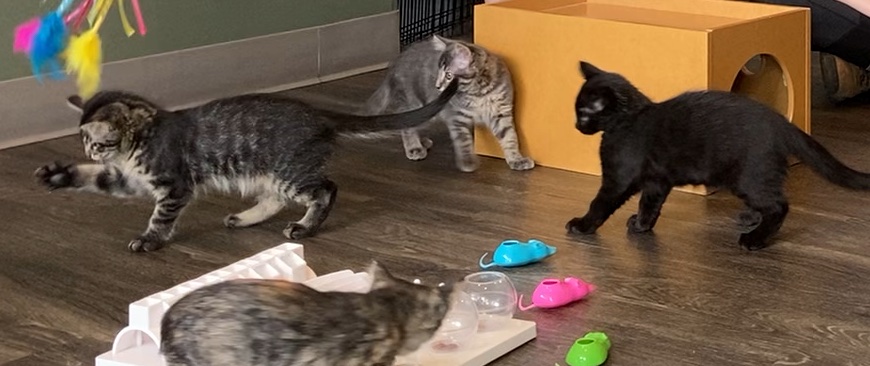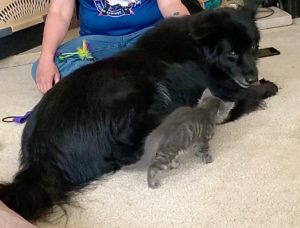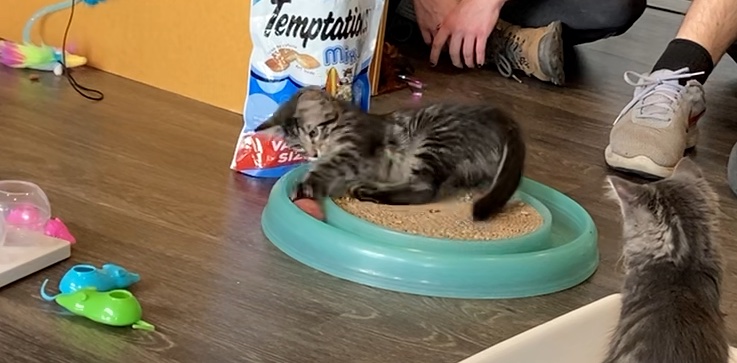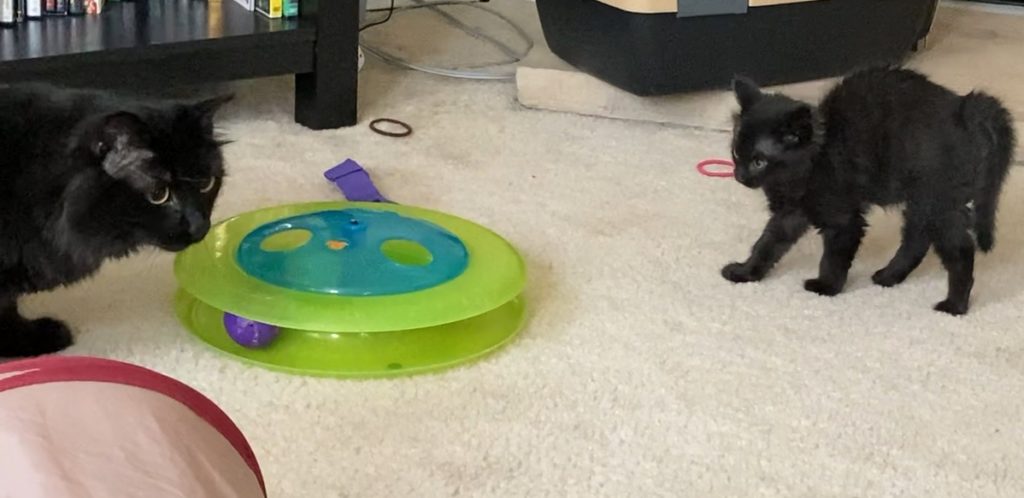
It’s hard to resist those cute little balls of fur. If you are smitten with a kitten, how do you know if a kitten is a fraidy cat? It is unlikely that you will know the details of how they were raised. What can you do?
that kitten is a fraidy cat
Kittens that are fearful at intake into the animal shelter are more likely to remain fearful of unfamiliar people and objects when they are old enough to be adopted (Reference 1). This makes them less likely to be adopted. How do you identify the fraidy cat?
A recent study observed the responses of 46 kittens 5-8 weeks old when they were confronted with 1) a stuffed dog 2) a stuffed cat and 3) a vacuum cleaner. The researchers found that fear behaviors in kittens are similar to those of an adult cat (Reference 1).
Many rescues will adopt out kittens at 8-10 weeks of age although recent research favors adopting kittens out at a later age, 12 weeks or more (Reference 2). Many rescues will allow you to visit with an adoptable kitten. How do you know if the kitten is fearful or not?
If a kitten is a fraidy cat, watch for the fear behaviors listed below (red box). You will often see these behaviors while the kitten backs up or runs away from a person or object. The green box lists behaviors of relaxed kittens.
that kitten is a fraidy cat
- Crouching: the kitten’s body is close to the ground with all four legs bent and their belly close to or touching the ground
- Tucked or lowered Tail: Tail is tucked under the body or wrapped around the hind legs
- Ears back or sideways (airplane ears)
- Hair on End – “Halloween cat”
- Freezing – like a statue for 2 seconds or more
- Slow Movements: walking slowly, cowering
- Flinching: kitten suddenly jumps or jolts
- Aggression: Kitten bites, swats, hisses
that kitten is relaxed
- Standing up – belly is held up and legs are naturally extended
- Tail up or straight out behind them
- Ears up and facing forward
- Eating – this is a sign of the kitten being relaxed
- Grooming – the act of grooming indicates that the kitten is relaxed
making your kitten comfortable
Whether the kitten you adopt is shy and retiring or bold and confident, it is important to provide them with an environment that the kitten feels safe in. Often, kittens are fostered in the homes of rescue volunteers to reduce their exposure to illness. A recent survey of foster care of kittens found that (Reference 3) :
- Kittens who spend most of their time in the social areas of the home (free access indoors or in the living room) are more friendly to people
- Kittens do better in quieter social areas
- Kittens who spent some time alone seem happier and more interested in playing with toys
what to do
- SET UP A SAFE PLACE: Set up a space for the kitten with a cozy place to sleep, some toys, water, and a litter box. This can be a spare room or walk-in closet in your house or apartment. You will use this area for quiet time and when there is too much stimulation for the kitten.
- IF THAT KITTEN IS A FRAIDY CAT: Keep the kitten in that safe place (spare room, walk-in closet) for the first few days after you bring them home. Supervise them as they first start to explore the house.
- IF THAT KITTEN IS A FRAIDY CAT: Visits to the social areas should be short at first. Start with a quiet room and work up to a normal noise level; start with one or two people and work up to a full house. Your “thermometer” is the kitten’s body language (see above) – if they seem anxious, return them to their “safe place”.
- KITTENS NEED QUIET TIME: Just like human children, kittens need to spend some time alone, away from housemates and people. Think of “quiet” time in kindergarten. The “safe place” gives kittens an opportunity to sleep and to play with toys on their own.
Be sure to handle the kitten in a gentle, predictable way.
The international cat rescue, ICatCare, recommends following a “five second rule”, where you play or handle the kitten for 5 seconds than assess if the kitten is still enjoying the interaction (Reference 4).
You can count slowly to 5, then see how the kitten is doing. Watch your kitten’s body language!
Experts recommend several weeks for animals to acclimate to a new environment – zoos and animal parks may take up to 30 days to allow animals to adjust to their new home, surroundings, and interactions with other animals (Reference 5). Plan to give your new kitten time to settle into your home – a gradual introduction to the household works best!
It is important to identify when that kitten is a fraidy cat and adjust socialization appropriately. Consider printing and posting the infographic of fear behaviors in kittens to refer to.
references
- Graham, C., Khalife, S., Pearl, D. L., Mason, G. J., & Niel, L. (2024). Tell-tail fear behaviors in kittens:Identifying the scaredy cat. Animal Behavior and Cognition, 11(4), 361-392.https://doi.org/10.26451/abc.11.04.03.2024
- Finka, L.R. Conspecific and Human Sociality in the Domestic Cat: Consideration of Proximate Mechanisms, Human Selection and Implications for Cat Welfare. Animals 2022, 12, 298. https://doi.org/10.3390/ani12030298
- Gemma R. Campbell, Elizabeth R. Arnott, Courtney Graham, Lee Niel, Michael P. Ward, Gemma Ma, Impact of early socialisation in foster care on kitten behaviour, Applied Animal Behaviour Science, Volume 276,2024,106306, ISSN 0168-1591,https://doi.org/10.1016/j.applanim.2024.106306.
- the icatcare-kitten-booklet for care, feeding and housing of your new kitten. See https://icatcare.org/resources/icatcare-kitten-booklet-2024.pdf
- DeGroot, Jen. “Ask the Expert: How do you acclimate an animal to a new habitat?”, Cleveland Zoological Society, September 27, 2021. https://www.clevelandzoosociety.org/z/2021/09/27/ask-the-expert-how-do-you-acclimate-an-animal-to-a-new-habitat

 10,000 years ago, the ancestors of our domestic cats decided to take advantage of the abundance of prey near and in human settlements. During this time, the social lives of cats changed from solitary hunters to members of structured, stable groups called colonies. Today’s free-ranging cats, particularly those that live in urban environments, depend on food provided by people, in addition to hunting rodents and raiding human garbage cans.
10,000 years ago, the ancestors of our domestic cats decided to take advantage of the abundance of prey near and in human settlements. During this time, the social lives of cats changed from solitary hunters to members of structured, stable groups called colonies. Today’s free-ranging cats, particularly those that live in urban environments, depend on food provided by people, in addition to hunting rodents and raiding human garbage cans.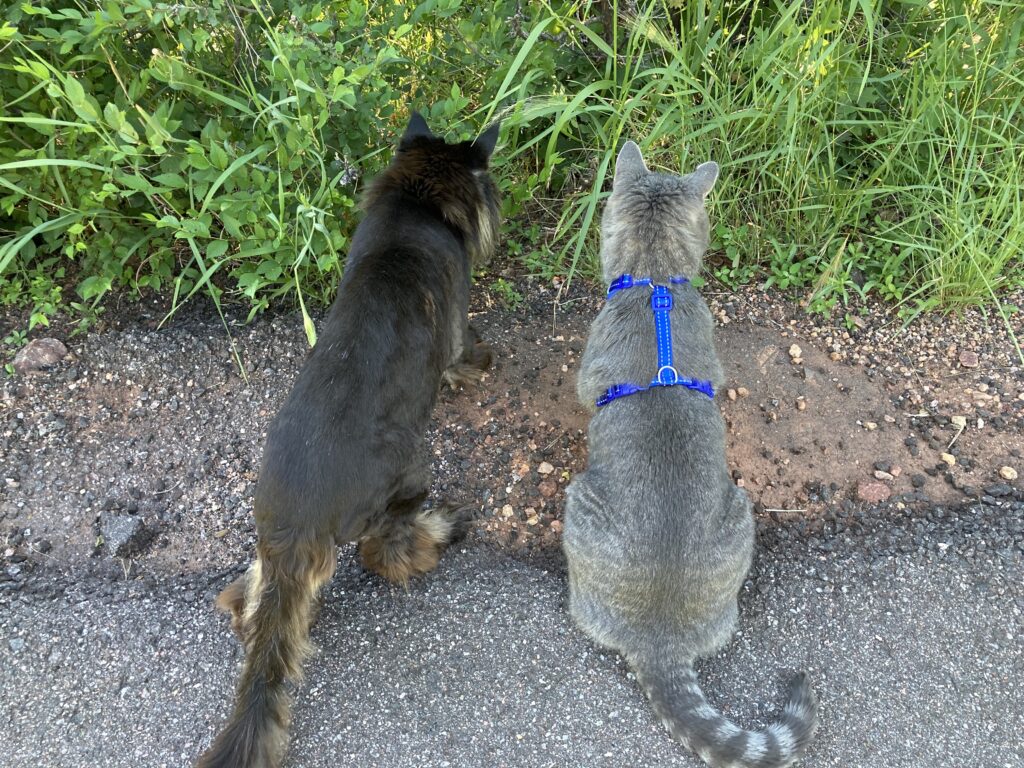
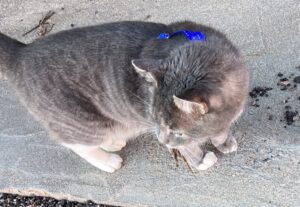
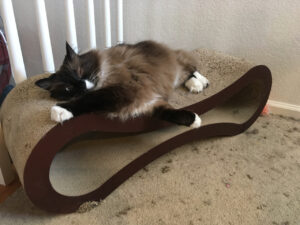
 This tall cat tree is located in the interior of the house away from doors and windows. The younger cats (6 years), Zelda and Gus, use this tower to snooze on the upper levels or to get to the tops of the kitchen cabinets. Although it does meet the recommendations for the ideal scratcher, the cats don’t scratch on this tree all that much.
This tall cat tree is located in the interior of the house away from doors and windows. The younger cats (6 years), Zelda and Gus, use this tower to snooze on the upper levels or to get to the tops of the kitchen cabinets. Although it does meet the recommendations for the ideal scratcher, the cats don’t scratch on this tree all that much. This very tall post (it is 41″) with sisal fabric is at the front door. It is popular with everyone, from the 17 lb Coon cat to the small senior at 8 lb. All four cats scratch before going out for a walk or when they sit to look out the window in the front door. The horizontal cardboard scratchers at the front door also see consistent use. The cats tend to use these with all 4 feet on the scratcher.
This very tall post (it is 41″) with sisal fabric is at the front door. It is popular with everyone, from the 17 lb Coon cat to the small senior at 8 lb. All four cats scratch before going out for a walk or when they sit to look out the window in the front door. The horizontal cardboard scratchers at the front door also see consistent use. The cats tend to use these with all 4 feet on the scratcher.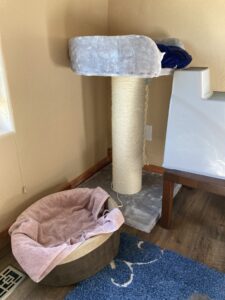 The sisal-covered base of this extra-large cat bed is tall enough for the large Maine Coon to scratch. This cat bed is located in the bedroom. It was purchased for the Maine Coon cat but has been taken over by 8 lb Athena, who sleeps in this bed or in her heated bed at the base of the scratcher. When she gets out of bed, she stretches and scratches on this scratcher. This is used infrequently by the other three cats.
The sisal-covered base of this extra-large cat bed is tall enough for the large Maine Coon to scratch. This cat bed is located in the bedroom. It was purchased for the Maine Coon cat but has been taken over by 8 lb Athena, who sleeps in this bed or in her heated bed at the base of the scratcher. When she gets out of bed, she stretches and scratches on this scratcher. This is used infrequently by the other three cats.
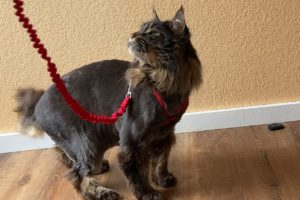
 Kitten kindergarten programs are great ways to continue to expose kittens to new experiences and accustom them to humans. But what if you can’t find one of these programs near you? Consider introducing your kitten to your friends and family in your own home.
Kitten kindergarten programs are great ways to continue to expose kittens to new experiences and accustom them to humans. But what if you can’t find one of these programs near you? Consider introducing your kitten to your friends and family in your own home. Lure your kitten out with treats or a toy. Allow her to approach people on her own – reward with a treat or play. Guests can take turns luring the kitten with toys, cuddling the kitten (if she accepts this) and offering snacks!
Lure your kitten out with treats or a toy. Allow her to approach people on her own – reward with a treat or play. Guests can take turns luring the kitten with toys, cuddling the kitten (if she accepts this) and offering snacks!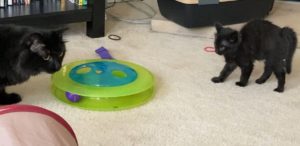

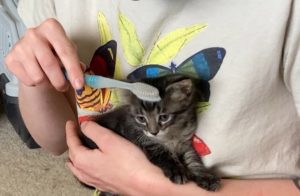
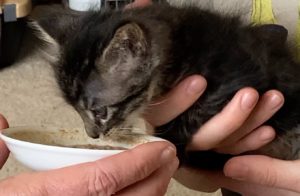 A human caregiver cannot replace a kitten’s mother – after all, we are not cats. For example, how does a human foster mimic the frustration accompanying weaning that encourages the kitten to get his own food? Kittens raised without their mothers and siblings are prone to behavioral issues – they don’t know how to deal with frustration; early separation from the mother may cause
A human caregiver cannot replace a kitten’s mother – after all, we are not cats. For example, how does a human foster mimic the frustration accompanying weaning that encourages the kitten to get his own food? Kittens raised without their mothers and siblings are prone to behavioral issues – they don’t know how to deal with frustration; early separation from the mother may cause 